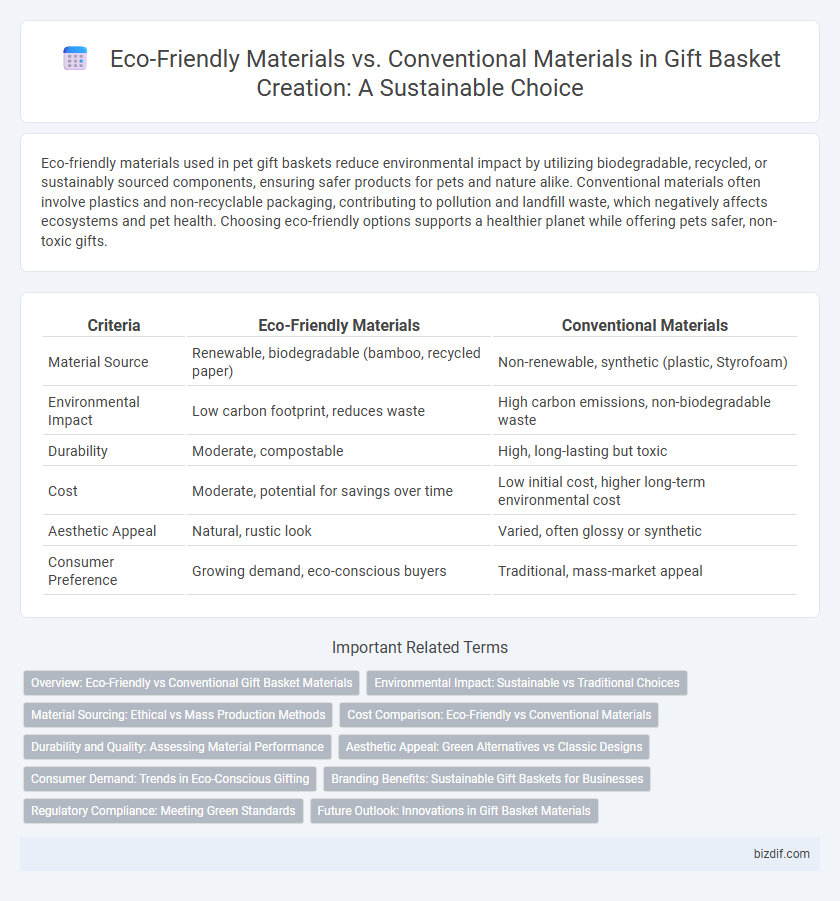Eco-friendly materials used in pet gift baskets reduce environmental impact by utilizing biodegradable, recycled, or sustainably sourced components, ensuring safer products for pets and nature alike. Conventional materials often involve plastics and non-recyclable packaging, contributing to pollution and landfill waste, which negatively affects ecosystems and pet health. Choosing eco-friendly options supports a healthier planet while offering pets safer, non-toxic gifts.
Table of Comparison
| Criteria | Eco-Friendly Materials | Conventional Materials |
|---|---|---|
| Material Source | Renewable, biodegradable (bamboo, recycled paper) | Non-renewable, synthetic (plastic, Styrofoam) |
| Environmental Impact | Low carbon footprint, reduces waste | High carbon emissions, non-biodegradable waste |
| Durability | Moderate, compostable | High, long-lasting but toxic |
| Cost | Moderate, potential for savings over time | Low initial cost, higher long-term environmental cost |
| Aesthetic Appeal | Natural, rustic look | Varied, often glossy or synthetic |
| Consumer Preference | Growing demand, eco-conscious buyers | Traditional, mass-market appeal |
Overview: Eco-Friendly vs Conventional Gift Basket Materials
Eco-friendly gift baskets utilize sustainable materials such as recycled paper, biodegradable fillers, and organic fabrics, significantly reducing environmental impact compared to conventional materials. Conventional gift baskets often use plastics, non-recyclable synthetic fibers, and chemical-based decorations, contributing to landfill waste and pollution. Choosing eco-friendly materials supports sustainability goals and appeals to environmentally-conscious consumers seeking greener gift options.
Environmental Impact: Sustainable vs Traditional Choices
Eco-friendly gift baskets use biodegradable and recycled materials that significantly reduce landfill waste and carbon footprints compared to conventional plastics and non-renewable resources. Sustainable choices like organic fabrics, natural fillers, and reusable containers support ecosystem health and minimize pollution during production and disposal. Traditional materials often rely on petrochemical processes, contributing to environmental degradation and long-term waste accumulation.
Material Sourcing: Ethical vs Mass Production Methods
Eco-friendly gift baskets utilize sustainably sourced materials such as recycled paper, organic fabrics, and biodegradable fillers, emphasizing ethical harvesting and fair labor practices to minimize environmental impact. Conventional materials often rely on mass production methods involving plastic components, synthetic fibers, and non-renewable resources, contributing to pollution and waste. Prioritizing ethical material sourcing enhances brand reputation and aligns with growing consumer demand for sustainable and socially responsible products.
Cost Comparison: Eco-Friendly vs Conventional Materials
Eco-friendly materials for gift basket creation often have a higher upfront cost compared to conventional materials, but they provide long-term savings through increased durability and reduced waste disposal fees. Conventional materials tend to be cheaper initially but may incur additional costs due to lower sustainability and environmental impact, such as higher waste management expenses and potential regulatory fines. Choosing eco-friendly options supports cost efficiency over time while aligning with sustainable business practices and consumer demand for green products.
Durability and Quality: Assessing Material Performance
Eco-friendly materials used in gift basket creation, such as recycled paper and bamboo fibers, often demonstrate high durability while maintaining eco-conscious quality standards. Conventional materials like plastic and synthetic fabrics may offer longer-lasting strength but pose environmental concerns due to non-biodegradability. Comparing material performance reveals that sustainable options increasingly match or exceed conventional materials in both resilience and aesthetic appeal.
Aesthetic Appeal: Green Alternatives vs Classic Designs
Eco-friendly gift baskets showcase a natural, rustic aesthetic using materials like recycled paper, bamboo, and jute, enhancing visual appeal through earthy tones and textures. Conventional gift baskets emphasize classic designs with glossy finishes, synthetic ribbons, and plastic fillers, offering a polished, vibrant look. The choice between green alternatives and classic materials significantly influences the basket's visual impact and alignment with sustainable values.
Consumer Demand: Trends in Eco-Conscious Gifting
Consumer demand for eco-conscious gifting has surged, with many preferring gift baskets made from sustainable, biodegradable materials such as recycled paper, organic fabrics, and plant-based fillers. Studies show that 67% of buyers prioritize environmentally friendly packaging, placing pressure on brands to transition from conventional plastics and non-recyclable wrappings. Brands incorporating eco-friendly materials see increased customer loyalty and align with growing global trends toward sustainability in gift presentation.
Branding Benefits: Sustainable Gift Baskets for Businesses
Eco-friendly materials in gift basket creation enhance brand image by aligning with growing consumer demand for sustainability, promoting positive corporate social responsibility. Using biodegradable packaging, recycled paper, and organic fillers differentiates businesses from competitors relying on conventional, non-recyclable materials. Sustainable gift baskets foster customer loyalty and attract eco-conscious clients, boosting brand reputation and long-term market value.
Regulatory Compliance: Meeting Green Standards
Eco-friendly materials in gift basket creation ensure strict adherence to international green standards such as FSC certification and the EU's Circular Economy Action Plan, promoting sustainable sourcing and reducing environmental impact. Conventional materials often face challenges in meeting these regulatory requirements, leading to higher risks of non-compliance and associated penalties. Using eco-friendly components not only facilitates compliance with evolving environmental laws but also enhances brand reputation and aligns with consumer demand for sustainable products.
Future Outlook: Innovations in Gift Basket Materials
Innovations in gift basket materials are shifting towards sustainable, eco-friendly options such as biodegradable fibers, recycled paper, and plant-based plastics, reducing environmental impact compared to conventional materials like plastic and Styrofoam. Research in mushroom mycelium packaging and seaweed-based wraps promises renewable, compostable alternatives that enhance durability and aesthetics. Market trends indicate rising consumer demand for zero-waste and recyclable gift basket components, positioning eco-friendly materials as the future standard in gift packaging.
Eco-friendly materials vs conventional materials Infographic

 bizdif.com
bizdif.com